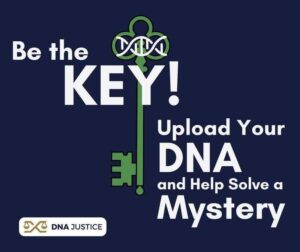Many people have asked me about the use of their DNA by law enforcement. Some are concerned, others just curious. So here is how it works.
 First of all, there are only two commercial databases where law enforcement is allowed in. Both of those, GEDmatch and Family Tree DNA (ftDNA), require you to opt in to that usage and inform you about it in their terms. There is also one non-profit – DNA Justice – just for Law Enforcement, where you can choose to opt in to be informed if your DNA solved a case.
First of all, there are only two commercial databases where law enforcement is allowed in. Both of those, GEDmatch and Family Tree DNA (ftDNA), require you to opt in to that usage and inform you about it in their terms. There is also one non-profit – DNA Justice – just for Law Enforcement, where you can choose to opt in to be informed if your DNA solved a case.
In order for your DNA to be helpful for solving cases, you have to upload your DNA test done elsewhere to any of those sites, although ftDNA will also do the actual DNA testing and even has some additional tests. In fact, I have a review of the great new Roberta Estes book about that site coming soon. Remember, Law Enforcement only uses your DNA for cousin matching, and perhaps ethnicity, but does not have access to your actual raw DNA data.
If you opt in to helping solve cases on those sites, then your DNA plus your family tree could be used to identify any 2nd or 3rd cousins that are unidentified bodies, rapists, or murderers. Unless you are a genealogist, you probably don’t know all your cousins, and there can even be a few unknown out-of-wedlock ones. I have discovered more of those on my own tree than I would have expected.
So why are so many reluctant to opt in? Fear of reprisals from the criminal? (they don’t know about you, so no worries) or just the reluctance to be a tattle tale? We have all been trained to guard our online privacy so perhaps that is where the discomfort comes from.
I explained the methodology of using genetic genealogy for identifications in a post (click here) I wrote just after the Golden State killer was found. It is the same set of techniques used to help adoptees. The important thing to understand is that genetic genealogy is just used as a tip to narrow down the possibilities. Then Law Enforcement collects the actual DNA of the suspect(s) and compares it to what they have for the perp before any arrests are made.

In the case of unidentified bodies, the trick is to get enough DNA from the degraded remains to create a DNA profile similar to a test kit and thus usable on those sites, The DNA Justice site says “There is so much work still to be done, with more than 14,000 listings in the National Missing and Unidentified Persons System (NamUS) alone.” Click here to read a few of the success stories on the DNA Doe site to see how important this work is.
Finally if you want an inside look at how this work is done read the book I Know Who You Are written by Barbara Rae-Venter. This compelling autobiographical book includes the details of how the Golden State Killer was found with genetic genealogy.
Here’s hoping more of you opt into helping out by uploading your autosomal DNA test results to these sites!
Great post, Kitty! Uploading to DNA Justice automatically opts you in. Be sure to read the Terms of Service and Privacy Policy to make an informed decision before you do. Everyone should be comfortable with what is a very personal choice. For those who weigh the risks and still do so, all of us working these cases thank you, on behalf of the families and communities waiting for answers.
Thank you Margaret, yes I know you are opted in to helping at DNA Justice Perhaps I should have used a different word to describe being asked if I wanted to know whether my DNA had solved a case, which is optional and still anonymous.
Pingback: This week's crème de la crème - July 13, 2024 - Genealogy à la carteGenealogy à la carte
It always interest me to learn more about how genealogy can be used in so many ways. Wow, building family trees, finding heirs, and now identifying victims and suspects! I’d heard that genetic genealogy can be helpful in law enforcement, but didn’t know any specifics. Thanks for this educational post!
I haven’t seen any commentary on the recent decision of FtDNA to freeze trees or have people link to a Myheritage tree.
Will people be more hesitant to open to law enforcement? How is this affected by MH privacy policies?
Certainly, my tree on FtDNA is tiny compared to my MH tree but comes with no caveats.
Ellen –
Good question, I will think about this. The trees at MyHeritage are often more complete plus they are often reproduced at GENI.com – the one world tree that I prefer to use.
As to these changes, Roberta Estes has blogged extensively about them.
https://dna-explained.com/2024/07/27/update-and-webinar-familytreedna-myheritage-tree-integration/
I intend to have a look next week when back from vacation.
40 years ago, our neighbor was murdered in our nice little suburban neighborhood. The man left his ski mask behind, but as he was not in any databases (and DNA was pretty young then, anyway), he remained unknown. About 10 years ago, the county added a forensic genealogist to its police force to look into some of these cold cases, and you can guess what happened: they finally got the guy.
I’d opted in, anyway, but once I understood exactly how they were using it (only for cold murder and rape cases, or to identify John-Jane Does), I felt like it was my responsibility to help in any way I could.
Thank you Elizabeth, spread the word!